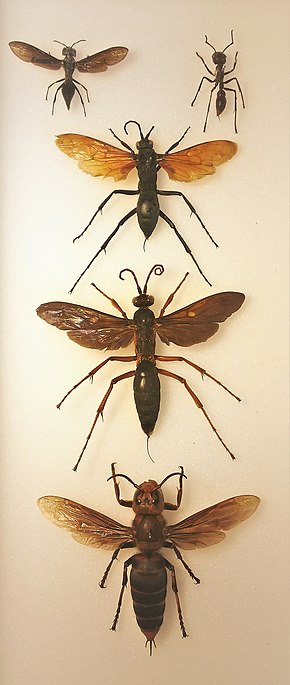| Schmidt sting pain index | |
|---|---|
 Some species representing the Schmidt sting pain index: Synoeca surinama, Paraponera clavata, Pepsis sp., Hemipepsis sp., and Vespa mandarinia. | |
| Purpose | Rates the pain of different stings |
The Schmidt sting pain index is a pain scale rating the relative pain caused by different hymenopteran stings. It is mainly the work of Justin O. Schmidt, who was an entomologist at the Carl Hayden Bee Research Center in Arizona. Schmidt published a number of works on the subject, and claimed to have been stung by the majority of stinging Hymenoptera.
His original paper in 1983 was a way to systematize and compare the hemolytic properties of insect venoms.[1] A table contained in the paper included a column that rated sting pain, starting from 0 for stings that are completely ineffective against humans, progressing through 2, a familiar pain such as that caused by a common bee or wasp sting, and finishing at 4 for the most painful stings; in the original paper, only the bullet ant, Paraponera clavata, was given a rating of 4. Later revised versions of the index added Synoeca septentrionalis, along with tarantula hawks as the only species to share this ranking. Descriptions of the most painful examples were given, e.g.: "Paraponera clavata stings induced immediate, excruciating pain and numbness to pencil-point pressure, as well as trembling in the form of a totally uncontrollable urge to shake the affected part."[1]
Schmidt repeatedly refined his scale, including a paper published in 1990, which classifies the stings of 78 species and 41 genera of Hymenoptera,[2] and culminating in a book published in 2016.[3]
While Schmidt's published scientific papers use a 1 through 4 number scale, an entry in The Straight Dope reported that "implausibly exact numbers" such as "bullhorn acacia ant at 1.8" were "wheedled out of him" by Outside magazine for an article it published in 1996.[4]
In September 2015, Schmidt was co-awarded the Ig Nobel Physiology and Entomology prize with Michael Smith for their Hymenoptera research.[5]
- ^ a b Schmidt, Justin O.; Blum, Murray S.; Overal, William L. (1983). "Hemolytic activities of stinging insect venoms". Archives of Insect Biochemistry and Physiology. 1 (2): 155–160. doi:10.1002/arch.940010205.
- ^ Schmidt, Justin O. (1990). "Hymenoptera Venoms: Striving Toward the Ultimate Defense Against Vertebrates". In D. L. Evans; J. O. Schmidt (eds.). Insect Defenses: Adaptive Mechanisms and Strategies of Prey and Predators. Albany, New York: State University of New York Press. pp. 387–419. ISBN 0-88706-896-0.
- ^ Schmidt, Justin (2016). The Sting of the Wild. Baltimore, Maryland: Johns Hopkins University Press. ISBN 978-1-4214-1929-9.
- ^ "Did the creator of the Schmidt Sting Pain Index volunteer to get stung by everything on earth?". The Straight Dope. 2012-05-11. Retrieved 2024-04-19.
- ^ Webb, Jonathan (18 September 2015). "'Universal urination duration' wins Ig Nobel prize". BBC News.